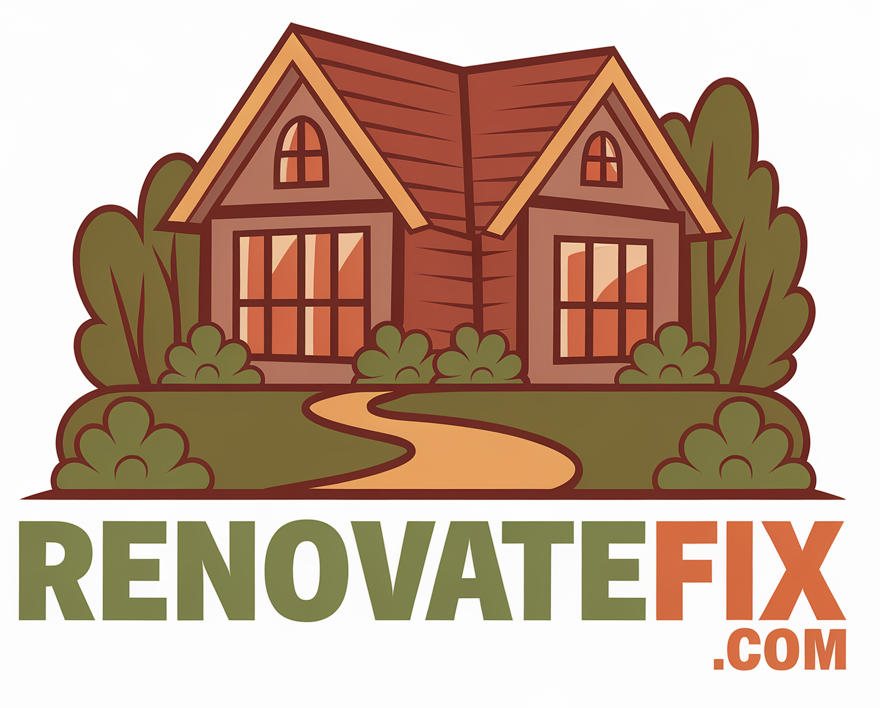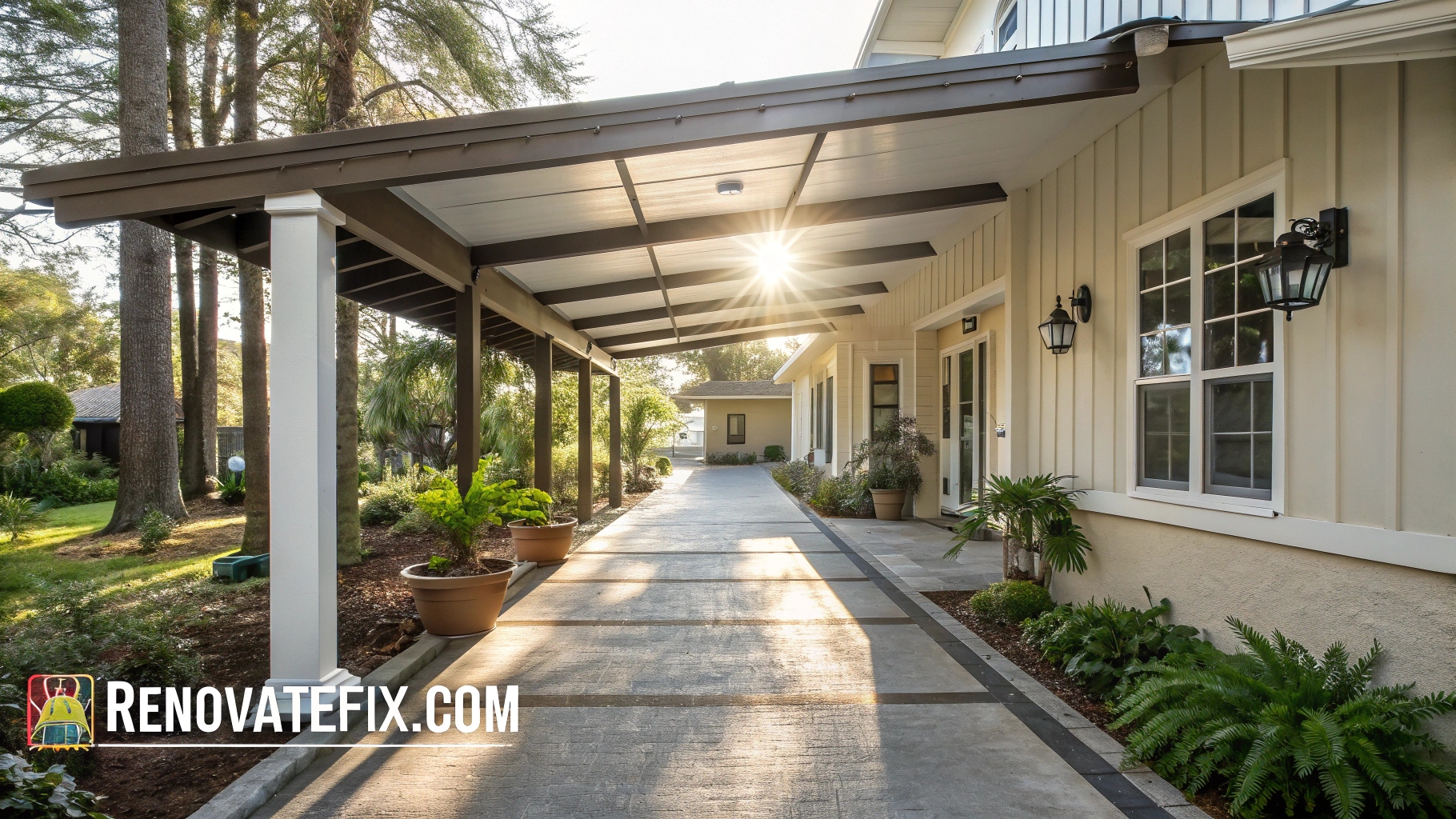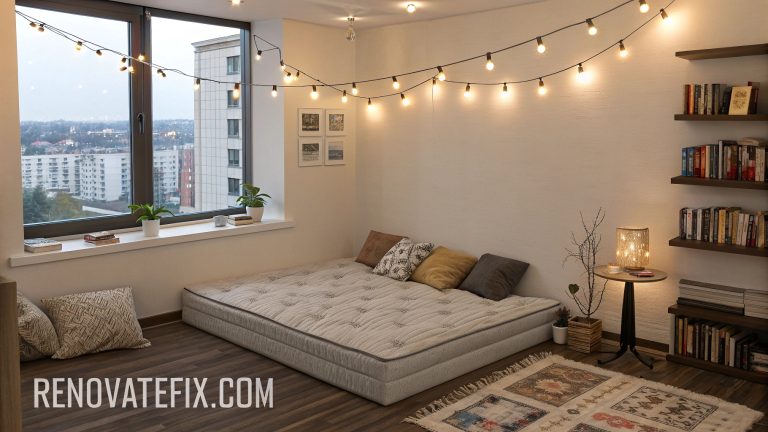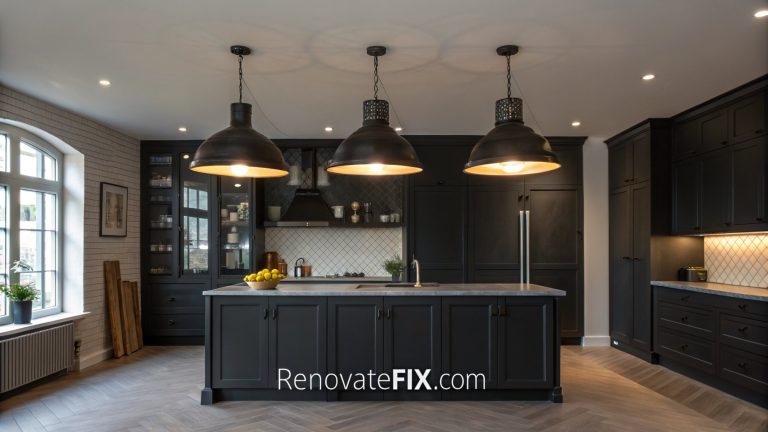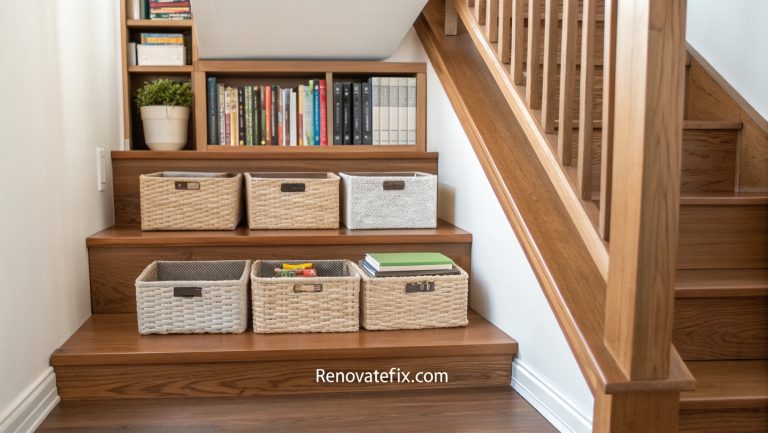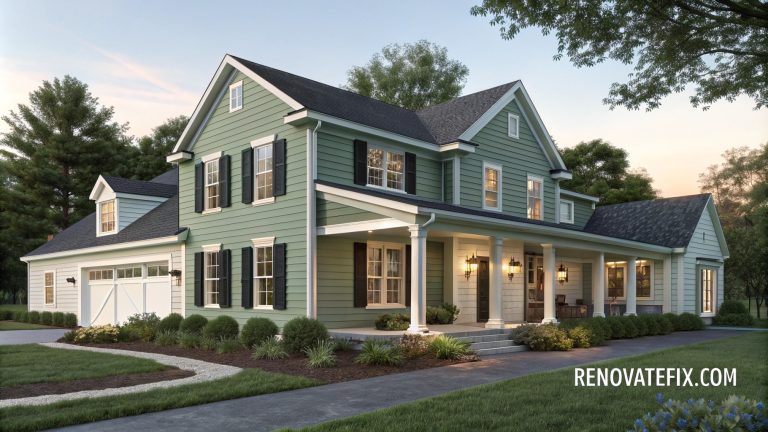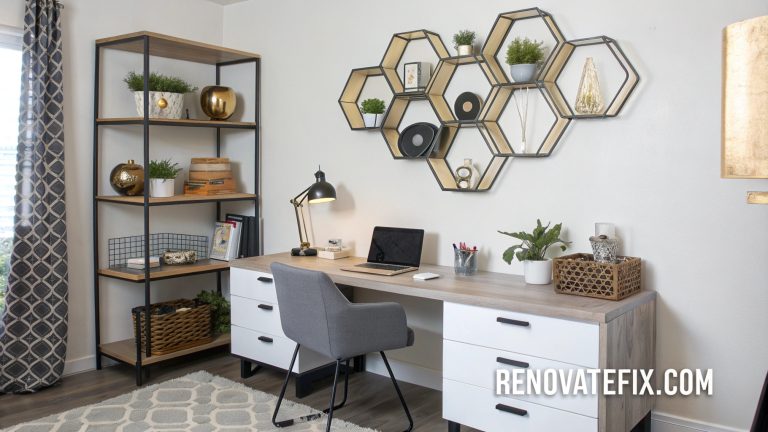20 Inspiring Carport Plans to Elevate Your Home’s Exterior
A carport offers practical protection for vehicles while enhancing your property’s appearance and value.
Unlike full garages, these open-sided structures provide shelter without extensive construction requirements or costs.
Whether you’re looking for something simple and economical or an architectural statement piece that complements your home, there are countless carport plans available to suit your needs.
This comprehensive guide explores twenty innovative ideas from traditional to modern approaches, considering various materials, sizes, and styles to help you find the perfect solution for your property.
20 Innovative Carport Plans
1. Classic Wood Post Carport
A straightforward wooden post carport delivers timeless charm with four sturdy columns supporting a pitched roof, creating an elegant yet practical vehicle shelter.

Natural lumber brings warmth to your driveway while offering customization through staining or painting to match your home’s exterior palette.
This approach works beautifully in both rural and suburban settings, particularly when paired with similar wooden architectural elements throughout your property.
2. Modern Flat Roof Metal Structure
Sleek aluminum framing supports a minimalist flat roof, creating a clean-lined silhouette that pairs perfectly with updated architectural styles.
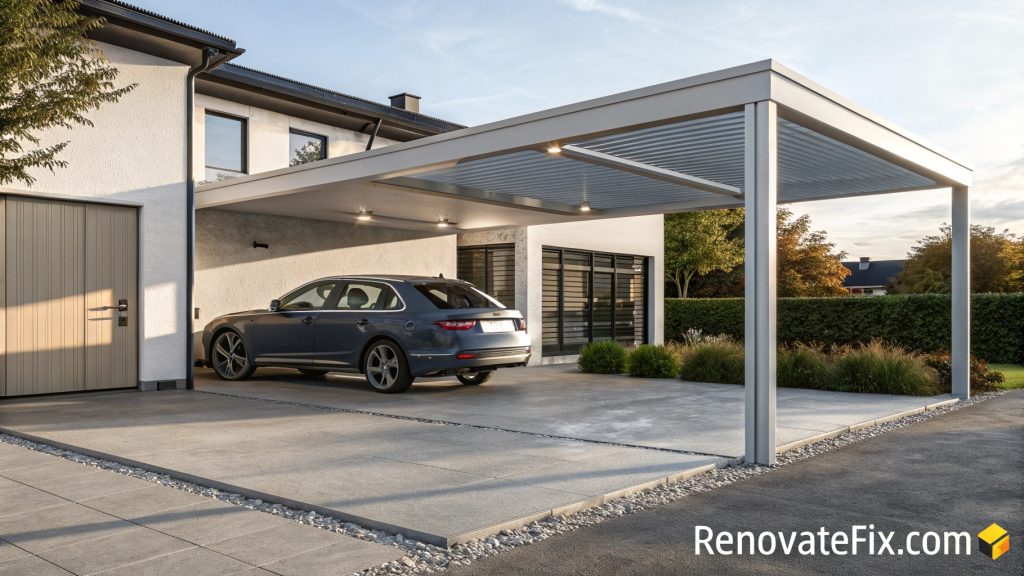
Industrial-inspired metal elements provide excellent durability against harsh weather while maintaining an unobtrusive visual profile.
This streamlined approach maximizes headroom and emphasizes horizontal planes, making it ideal for homes with geometric facades or mid-century inspiration.
3. Breezeway Connection Option
Link your main dwelling to a detached garage or accessory building with a functional passageway carport, establishing both vehicle coverage and a protected walkway between structures.
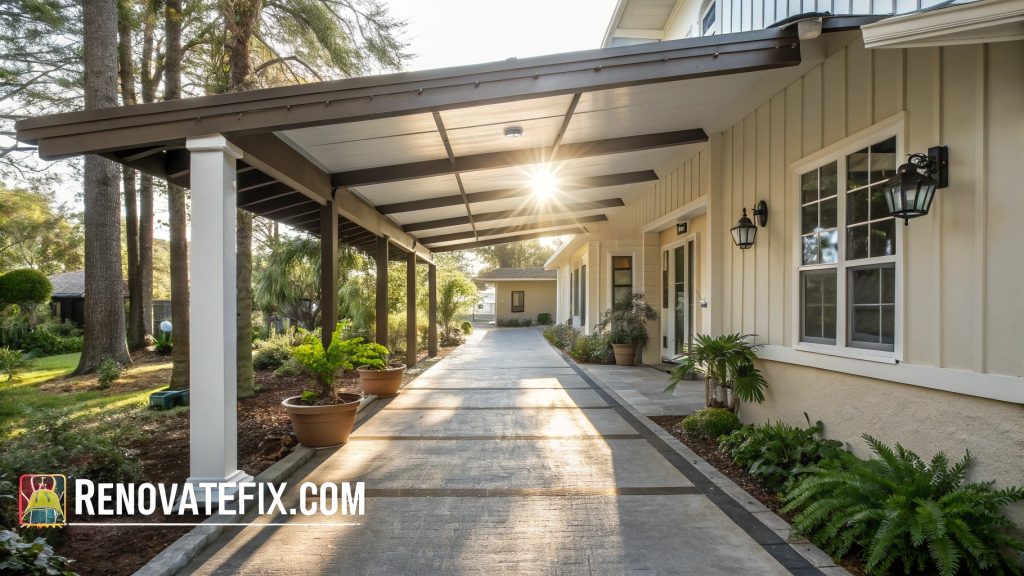
This multi-purpose solution effectively unifies separate buildings while creating an additional outdoor living zone that can host seating or container gardens.
Breezeway designs particularly benefit properties with multiple buildings, adding cohesion to the overall layout.
Image Prompt: Connected breezeway carport linking house to detached structure, walking path beneath roof, potted plants along edges, dappled sunlight filtering through, architectural harmony.
4. Cantilevered Floating Cover
Bold architectural statements emerge from cantilever construction where support comes from just one side, creating a dramatic floating roof effect without obstructive poles on the opposite end.
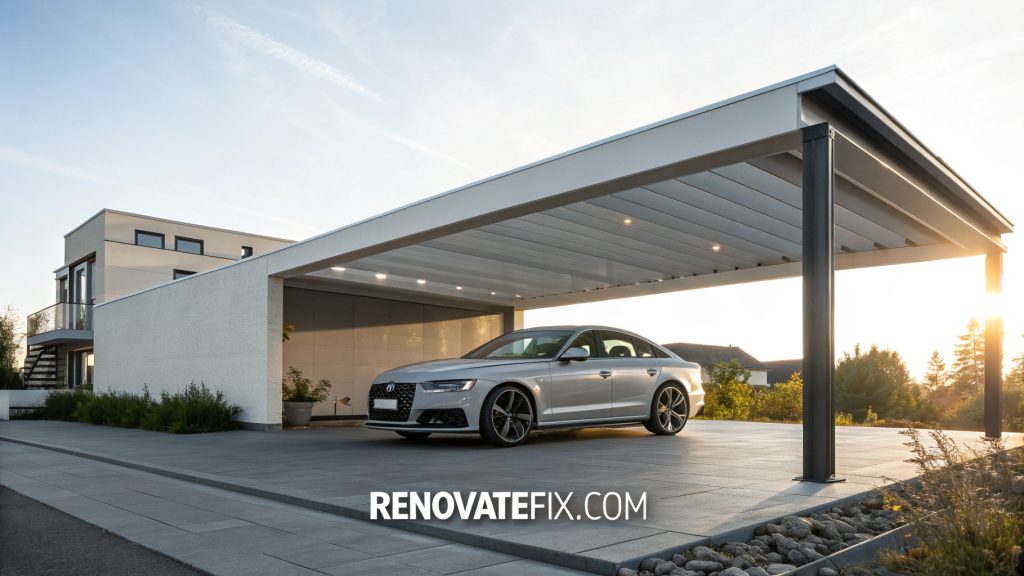
Engineering prowess meets striking aesthetics in this approach that maximizes open access and uninterrupted sightlines.
Advanced materials enable these gravity-defying structures that work especially well against contemporary homes with similar architectural bravado.
5. Rustic Timber Frame Structure
Massive exposed beams and mortise-tenon joinery showcase traditional woodworking craftsmanship in a carport that brings mountain lodge aesthetics to your driveway.
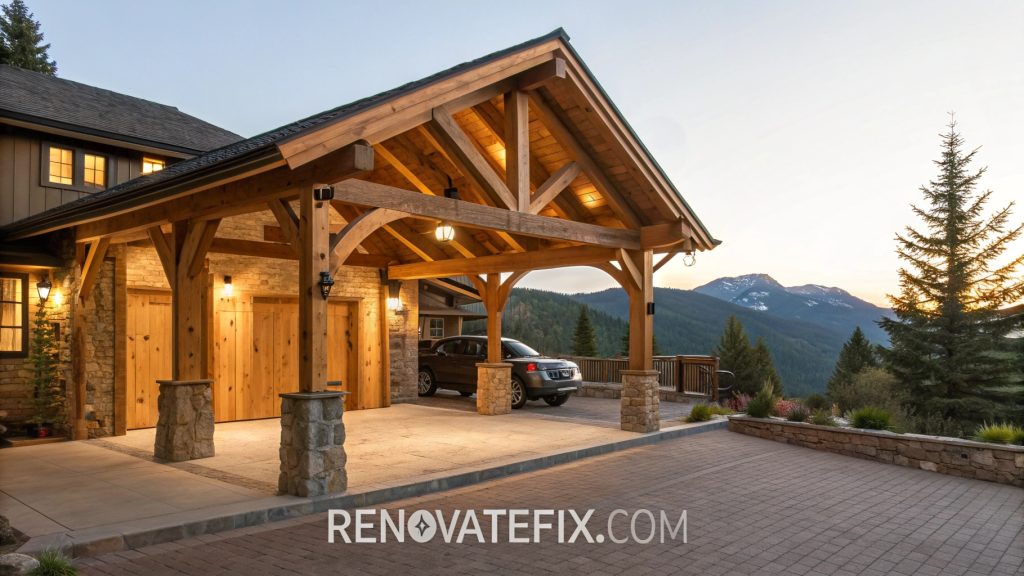
Heavy timber construction offers exceptional strength and visual impact, particularly when featuring natural wood grains and authentic construction methods.
This approach works wonderfully with craftsman, mountain, or country-style homes where authentic materials and visible structural elements are celebrated.
6. Pergola-Style Roof System
Semi-open lattice roofing provides filtered sunshine while still offering substantial rain protection, creating a garden-inspired atmosphere above your vehicle storage area.
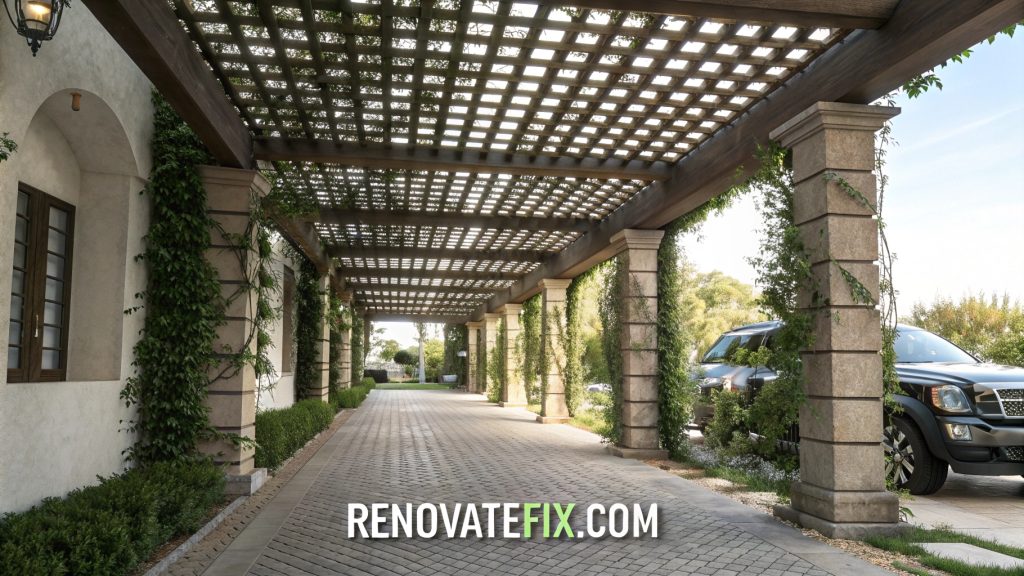
Climbing vines or trailing plants can eventually adorn this structure, blending automotive space with landscape architecture.
This partial-coverage approach works beautifully in mild climates where complete weather protection isn’t always necessary.
7. Arched Framework Design
Graceful curved supports create visual movement and architectural interest while providing substantial strength through arch physics principles.

Flowing lines soften the utilitarian purpose of vehicle storage, bringing artistic elements to functional structures.
This distinctive silhouette stands out among standard carports and works especially well with homes featuring curved architectural details or Mediterranean influences.
8. Solar Panel Integration
Power-generating roof panels turn vehicle protection into an energy-producing asset, combining practical coverage with sustainable electricity production for household needs.
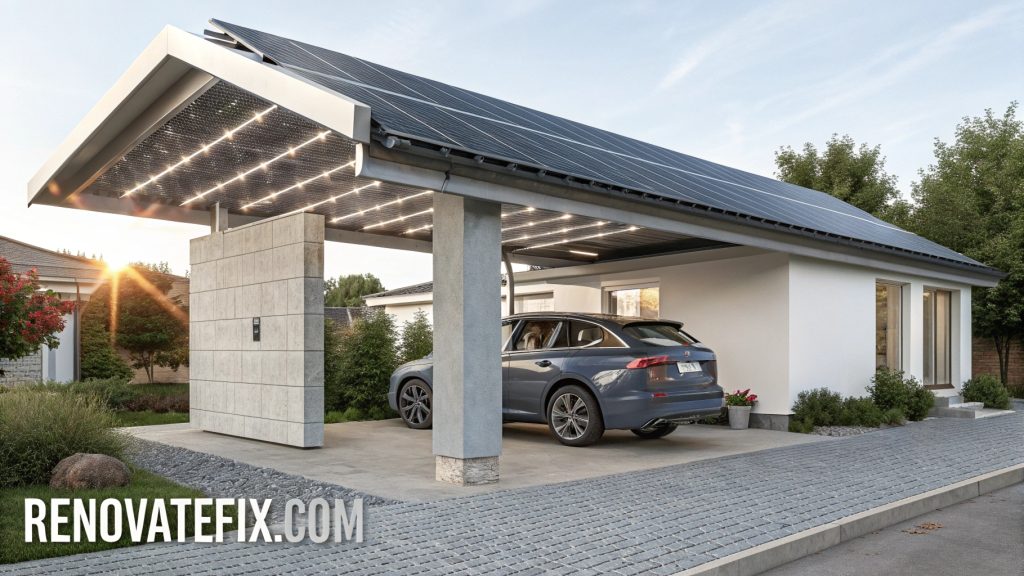
South-facing orientation maximizes sun exposure while angled panels shed precipitation effectively, perfectly merging function with eco-friendly technology.
This forward-thinking approach particularly benefits homes seeking energy independence and reduced utility costs.
9. Green Living Roof System
Vegetation-covered roof surfaces bring biodiversity and stormwater management benefits to your carport while visually connecting the structure to surrounding landscape elements.
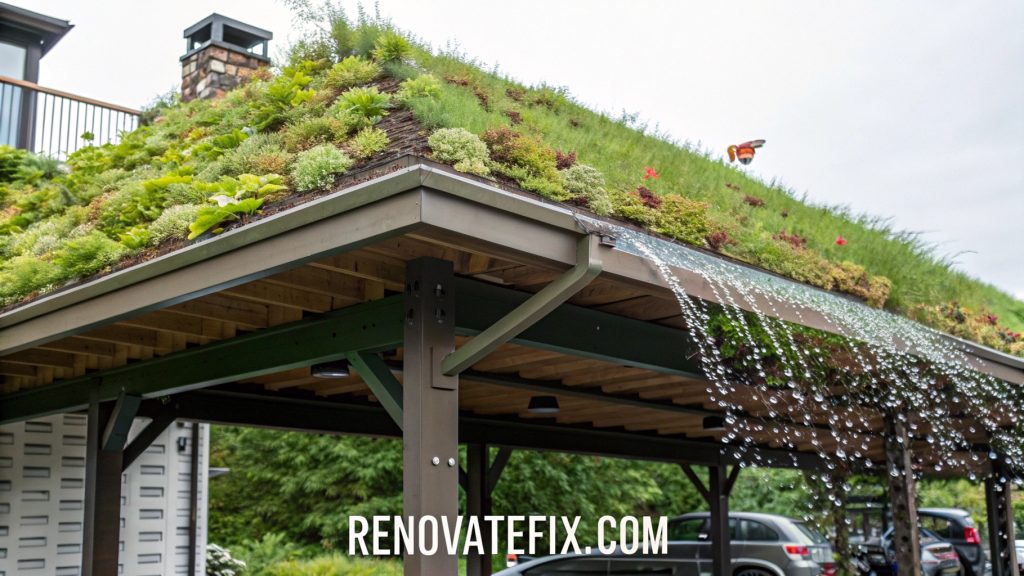
Drought-resistant sedums or native grasses thrive in shallow growing medium, creating an ecologically valuable space above your vehicle.
This natural approach significantly softens the appearance of utilitarian structures while improving local microclimate conditions.
10. Bamboo Construction Alternative
Sustainable bamboo poles create striking architectural visual interest while utilizing rapidly renewable materials that offer impressive strength-to-weight ratios.
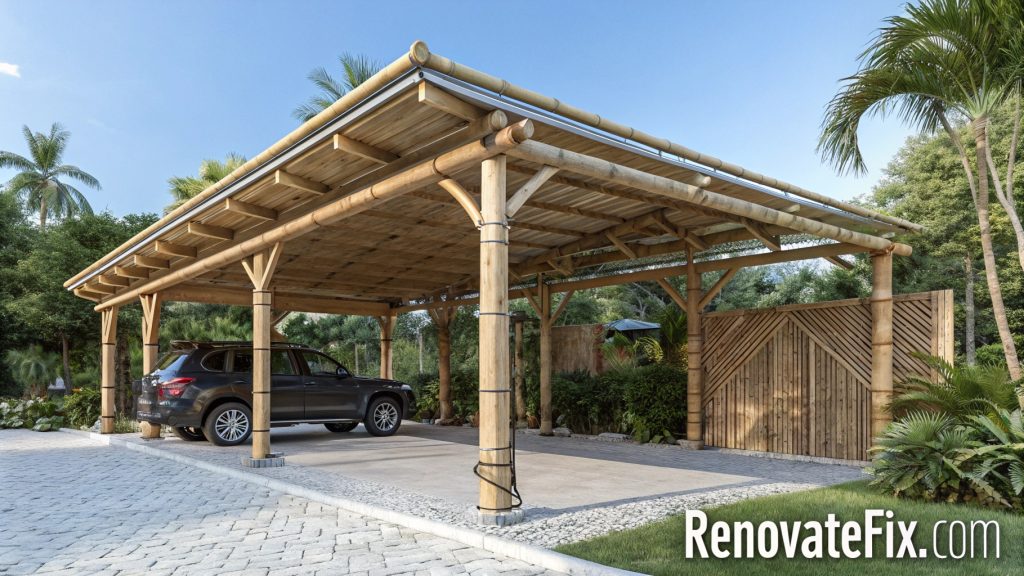
Natural variations in each bamboo culm ensure a uniquely organic appearance unlike standard lumber construction methods.
This eco-friendly approach brings tropical or Asian-inspired aesthetics to your property while showcasing environmental consciousness.
11. Glass Panel Roof System
Transparent or translucent overhead panels allow natural illumination while maintaining complete weather protection, creating an almost conservatory-like atmosphere above your vehicle area.

Specialized glass or polycarbonate materials filter harmful UV rays while allowing ambient light to flood the space below.
This approach works particularly well for dark driveways or areas where additional natural light would benefit surrounding spaces.
12. Modular Expandable Framework
Adaptable structural systems enable future expansion or reconfiguration as needs change, allowing homeowners to start with basic coverage and add sections over time.

Standardized components facilitate modifications without complete rebuilds, making this approach budget-friendly and forward-thinking.
This practical solution works especially well for growing families or properties likely to change vehicle requirements over coming years.
13. Brick Column Supports
Masonry pillars provide substantial structural integrity while bringing classical architectural elements to your carport, harmonizing with brick homes or traditional landscapes.
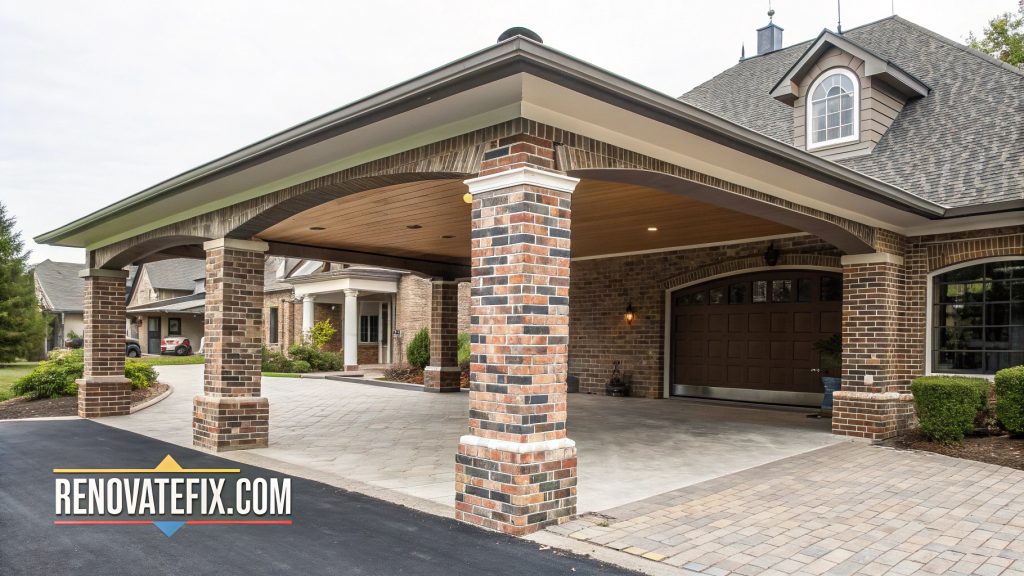
Varied brick patterns or contrasting mortar joints add visual interest to these permanent, low-maintenance supports.
This enduring approach suits properties with existing masonry features, creating cohesion throughout the exterior design language.
14. Sail Shade Fabric Cover
Tensioned waterproof fabric creates dynamic, wave-like forms overhead while providing effective protection from sun and precipitation with minimal structural requirements.
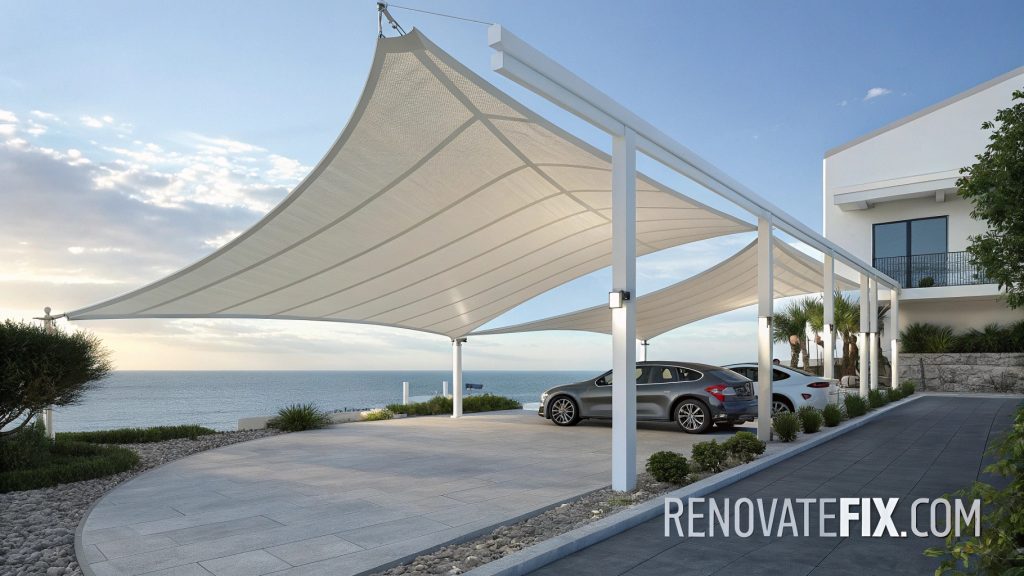
Flowing lightweight materials bring movement and soft visual appeal compared to rigid roofing options.
This approach works particularly well in coastal or resort-style properties where flowing, nautical aesthetics enhance the overall ambiance.
15. Log Cabin Style Construction
Round timber logs stacked or arranged in traditional frontier building techniques create rustic charm while providing substantial weather protection and visual warmth.

Pioneer-inspired construction methods showcase natural material characteristics and historical building approaches.
This distinctive style perfectly complements mountain retreats, hunting cabins, or properties celebrating American frontier aesthetics.
16. Asymmetrical Roof Pitch
Dramatic sloping roof planes create visual dynamics and improved water runoff while establishing an architectural focal point through unexpected angles and proportions.
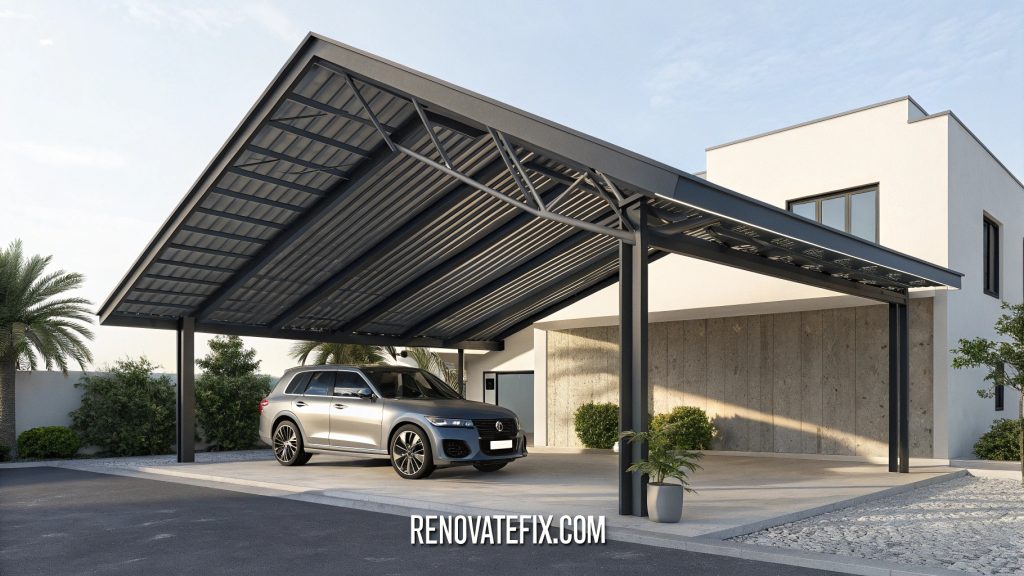
Conventional construction methods meet unconventional geometry in this approach that breaks from standard symmetrical designs.
This bold choice works especially well with homes featuring similar angular elements or where creating visual interest is a priority.
17. Repurposed Material Construction
Salvaged architectural elements find new purpose supporting vehicle shelter while bringing history and character through weathered patina and unique components.
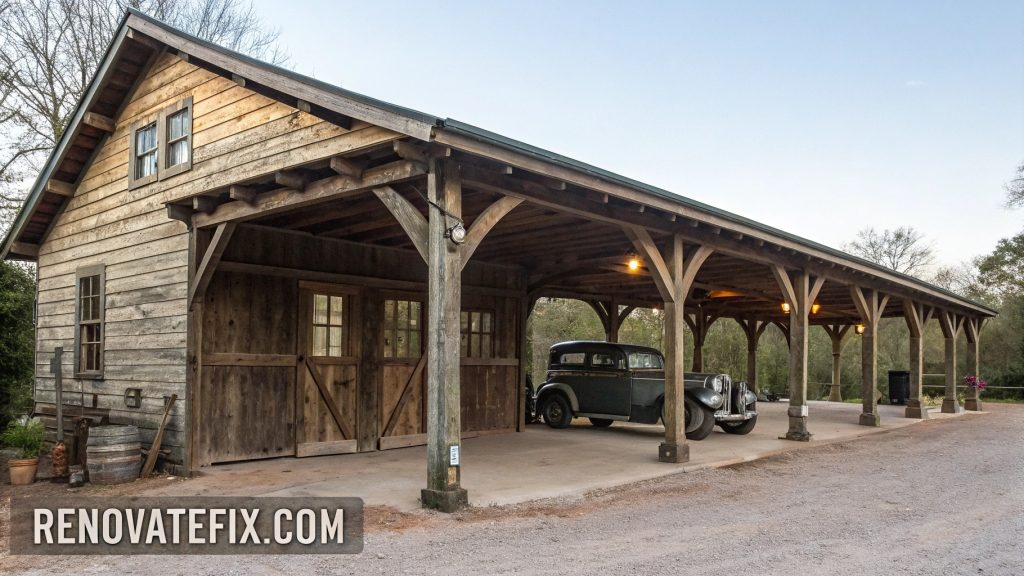
Old barn beams, factory windows, or vintage hardware tell stories through their previous lives while creating truly one-of-a-kind structures.
This sustainable approach reduces landfill waste while creating distinctive carports impossible to duplicate with new materials.
18. Wrapped Corner Solution
Angled L-shaped protection wraps around building corners to maximize coverage while minimizing footprint, creating efficient use of limited property space.

Multiple vehicles find shelter in this compact arrangement that hugs existing structures rather than extending straight outward.
This space-efficient approach particularly benefits urban properties or narrow lots where standard rectangle carports would consume valuable outdoor area.
19. Semi-Enclosed Louvered Sides
Adjustable slat panels provide customizable protection from elements while maintaining airflow and filtered visibility through partial wall coverage.
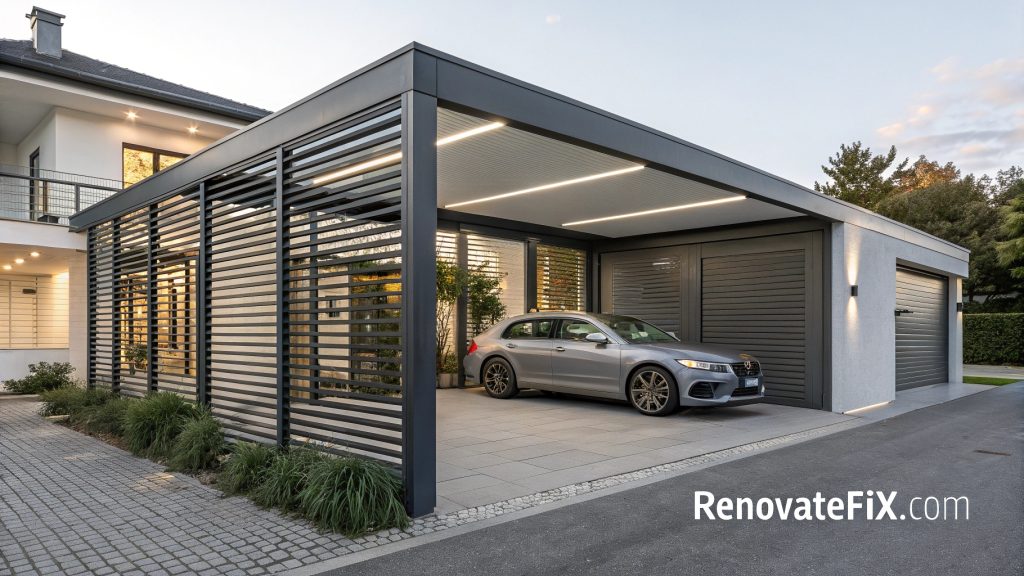
Movable sections adapt to changing weather conditions or privacy needs throughout seasons and situations.
This versatile approach offers more protection than standard open carports while avoiding full garage construction costs.
20. Multi-Level Parking Solution
Stacked or terraced vehicle protection maximizes limited property space through vertical orientation rather than sprawling footprints, particularly beneficial for sloped terrain or tight urban lots.
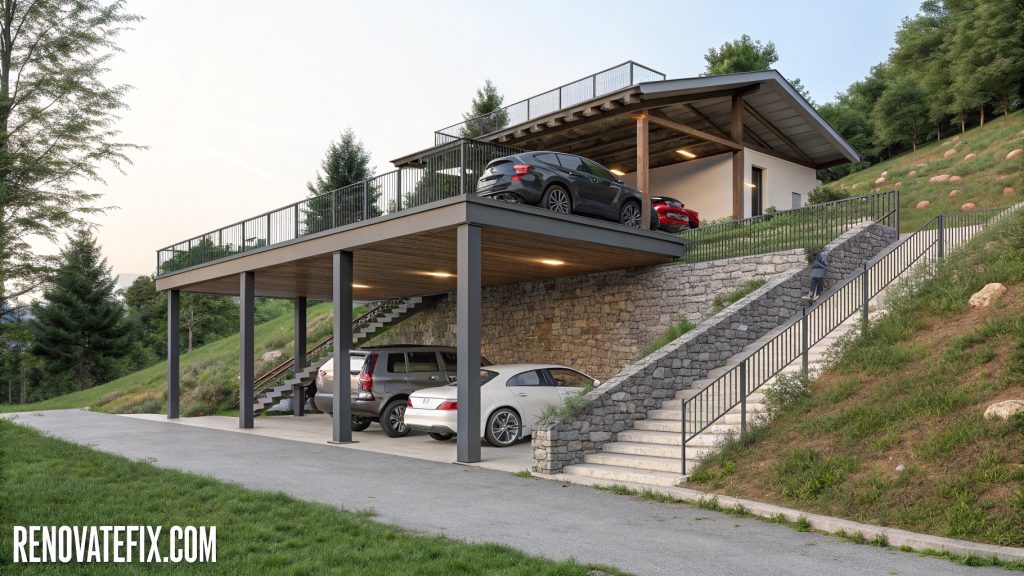
Split-level approaches efficiently accommodate multiple vehicles while following natural topography or existing structural elements.
This innovative design makes carport options viable even for properties previously considered too challenging for conventional approaches.
Conclusion
The right carport plan balances practical vehicle protection with aesthetic harmony alongside your home.
Whether opting for traditional styles with natural materials or pursuing cutting-edge architectural statements, these twenty ideas demonstrate how functional structures can enhance both property value and visual appeal.
Consider your climate requirements, available space, budget constraints, and architectural context when selecting your approach.
With thoughtful planning and quality construction, your carport will provide years of vehicle protection while becoming an integral part of your property’s exterior design story.
